Monitoring Competitors on Social Media: 5 Ways to Learn From Your Rivals’ Strategies

Take a deep breath. Open your Facebook page. In Facebook search, type the company name of your most hated competitor. Look how many ‘likes’ they have. 
But probably you knew this number by heart anyway.
There are many ways to treat your competition.
You can:
a) Ignore them. What’s the point of constantly reading about someone more popular than you?
b) Envy them. They deserve all your dark thoughts, they really do.
c) Copy, ahem, take ideas from them. Let’s go through details of how & why you should do that last thing.
First, your competitors might be spying on you. Moreover, they might be using you as a way to promote themselves!
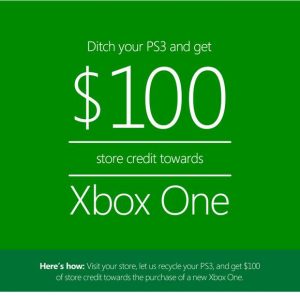
There are many great examples of exciting holy wars that come out of responses to competitors’ ads. Arguably, they raise sales for everyone involved. Even if your competitor hasn’t attacked you in a social media or marketing post, why not make the first move? :)

And second, you can get a lot of information you need by simply monitoring your competitors on social media, so long as you are doing it regularly and applying what you have learned to your business.
So, what should you do as part of social media competitive analysis?
1. Discover the best social media platforms for your business.
Facebook, Twitter, Instagram, YouTube — there are far too many social media platforms in this world. The number of platforms your competitor uses will tell you the extent of their social media engagement. The type of platform your competitor uses the most will tell you what kind of customers they target. For example, an extremely popular platform - Twitter - is only widely used among young men and women — 23% of online adults are on Twitter.
Haven’t decided what platforms to throw your budget on (because let’s face it, it’s hard being everywhere)? Let your competitors experiment, and later choose the one that has worked for them.
For example, although the Scottish craft beer company BrewDog is very active on every major social platform (they post a couple of times a day), it is Twitter and Facebook that drives their brand exposure.
As their competitor with limited resources, it would make sense for you to concentrate on these platforms rather than any other.
Besides, if you look outside of social media platform and into the Web, you’ll see that BrewDog gets much attention in the news. Mainly due to controversial advertising and craft beer ideas.

Ideas like this might inspire you. In some way.
2. Learn from monitoring customers’ engagement.
Now that by doing social media competitive analysis you've found out what kind of market they target (they might well look for right customers on a number of platforms), it’s time to find out how successful they are. Now don’t be fooled. It’s not the number of “likes” that counts. It’s the customers’ engagement. It’s how much they share and comment on what you post that determines how much they see of your future content.
What can you learn from monitoring customer’s engagement? Basically, how good your competitors are with social media. Are they being creative in a way you haven’t thought of before? Are they providing good customer support (replies within a day) or do they just work until 5 pm?

ake a note of everything you think they do well and not so. Needless to say, repeat what works!
Examples of outstanding one-off ideas that led to a massive rise in social media engagement include Bodyform’s hilarious response to a Facebook post, personal Maes Beer approach, and a priceless customer service move from Morton’s Steakhouse.
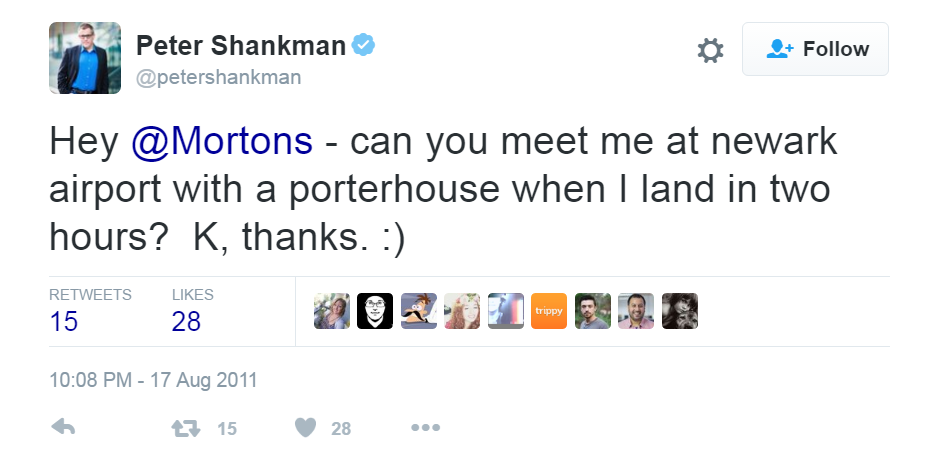
Yes, they did that.
3. Take ideas from your competitors' content.
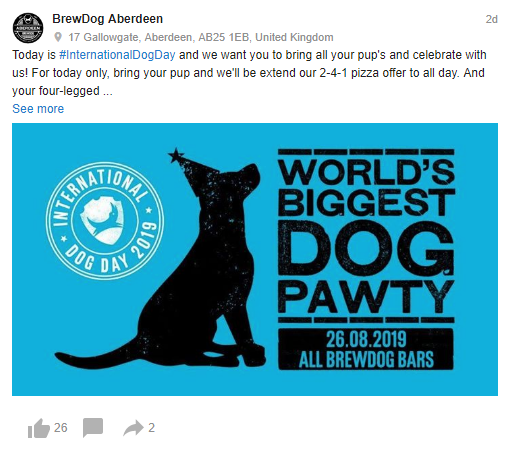
You should know what your competitors post for a number of reasons. First, as we all know, it’s easy to run out of content ideas.
Of course, don’t copy their content, that’s just wrong. But you can write on the same topic with your own take on a subject, and you might also find a content gap that you know something about. Second, try your best to understand what your competitor’s popular posts have in common. Is it a controversial topic, a relevant one, a funny one? Maybe it’s not content at all that makes people read it?
Most offline stores/services don’t actually post any rich content. Neither does BrewDog, so I had to move from craft beer to books (I know, that’s not a terribly logical shift). So recently Waterstone’s started posting reviews of books shortlisted for this year’s Baileys Women’s Prize for Fiction. A pretty good idea, right? Change it to the ‘Most popular books” reviews, and you have an online community ready to discuss that, and customers getting interested in new purchases!
Still, to stick with the structure, I’ll mention that most popular BrewDog posts include a question to the audience. People don’t necessarily reply, but they enjoy being asked their opinion on something as intimate as beer :)
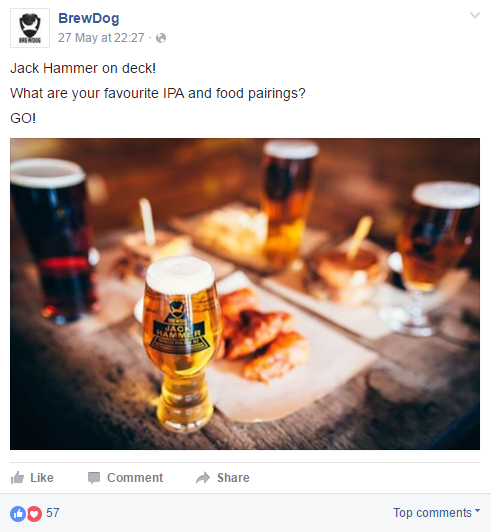
4. Dig deeper into the relationships of your competitors and their customers.
Now you know where your competitor’s customers hang out and how much they engage with your competitor. To get more meaningful results, monitor competitors on social media to find out what mentions about your competitor actually say. Do they praise some features that you don’t have (or the ones you have, but don’t advertise much)? Do customers complain about some aspects of their service that you can solve?

Not craft enough? Well, you are! Let them know.
5. Find common influencers.
Find the most influential authors that have mentioned your competitors' products and reach out to them. Most likely, they will be interested in your product, especially if it differs in some important way from the one they have already covered. Although BrewDog’s audience is most active on Twitter, they get the biggest attention on YouTube.
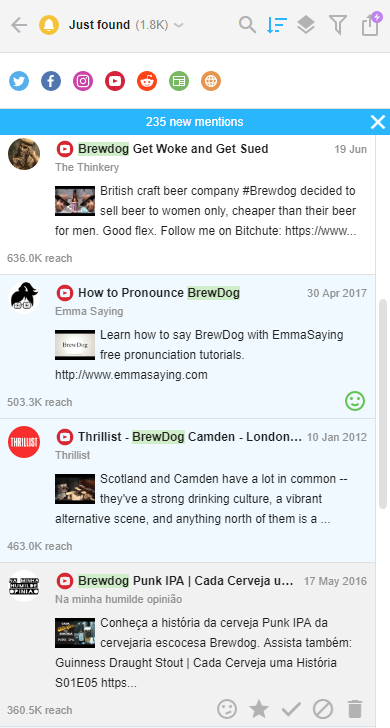
This isn’t surprising, as YouTube videos on alcohol/food tasting are indeed very popular.
Now that you have a load of information on your competitors.
What do you need to do with it?
-
Find a point of difference (or a number of them).

There is nothing worse than hearing from your client “I’ve just heard the same list of features from brands X and Y. You are all the same.” The more you know about competitors, the easier it will be for you to find how you stand out. For example, as a BrewDog competitor, you might want to stress that although you are as “punk” and “independent” as they are, your brand doesn’t push it to the extreme.
In a more tame example, a hobby store “ThinkGeek” claims it is all about the community, as opposed to other geek stores that look down on anyone who hasn’t read all Superman comic books.
-
Analyze their strengths and weaknesses.
It is difficult to keep anything hidden if you are online. Everything from the number of online mentions about your competitors to specific complaints and praises will provide you with information on their strengths and weaknesses. Based on that you can develop your own product, adjust your advertising campaigns, see what works as an online strategy and copy it.
-
Counteract their activities more effectively.
Your strategies are determined by your competitors to a huge extent. Advance your strategies based on what you have discovered about your competitors. Small businesses counteract big ones through offering a unique and personalized approach as opposed to a standardized and impersonal one. This way independent breweries get to the point of exporting artisan beers to 17 different territories and small coffee shops compete with huge chains like Starbucks.
Final words
The good part about monitoring competitors on social media is that it is never a waste of time. You will definitely learn something if you monitor regularly, even if it is that you are exactly on the same page as your competitors are. To perform a complete social media competitive analysis, set up an alert in Awario and find out everything customers say about them.
By signing up I agree to the Terms of Use and Privacy Policy













